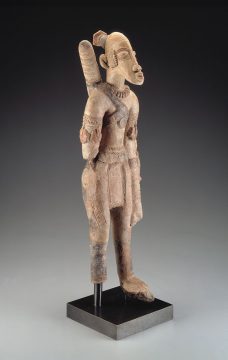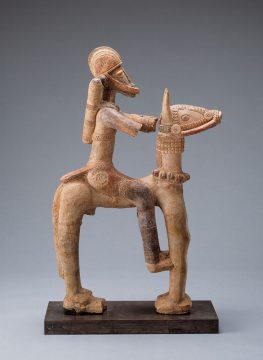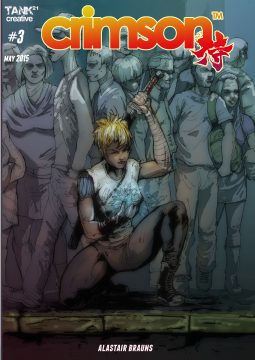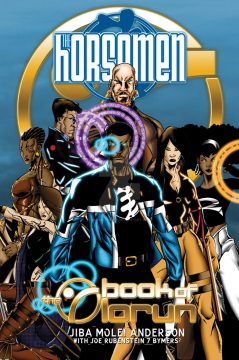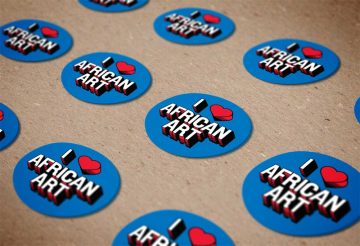
Home | That Liberty and Equality Might Yet Reign | Legends—Looking Back, Facing Forward | Divine Endurance: Ethiopia | Our Ancestors Lived Free | We Are…: Women Warriors | A Long Walk to Freedom: South Africa | Independent Africa Faces Forward
Legends—Looking Back, Facing Forward
“Imperialism leaves behind germs of rot which we must clinically detect and remove from our land but from our minds as well.”
—Frantz Fanon, The Wretched of the Earth
Inland Niger Delta artists / Bamana artist
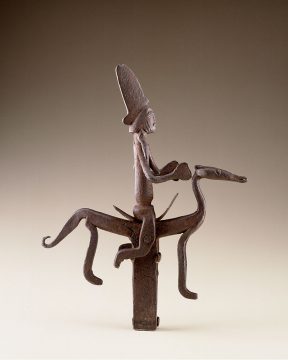
Vicinity of Bougouni, Sikasso region, Mali
Staff finial with female rider
Early to mid-19th century
Gift of Joseph H. Hirshhorn to the Smithsonian Institution in 1966, 85-19-1
Don’t cross this woman warrior. The rider wears a hat like those worn by other important persons in the Mande world, including hunters, ritual specialists, and the praise singers and historians known as griots. The portrayal of a female rider, in particular, recalls those women who acquired power and earned respect through force of character or ability as a sorcerer and are affiliated with hunters’ associations. The horse suggests the historical memory of the powerful cavalry that dominated Mali for centuries. Such staffs were displayed on special occasions to commemorate ancestors or placed near areas sacred to powerful Bamana religious groups. This sculpture was once part of a longer iron staff, likely carried by a Bamana chief.
Hero in History: Sundiata Keita
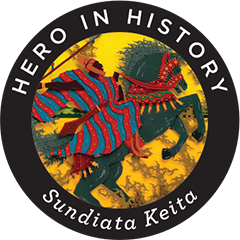
- According to Mande oral traditions, Sundiata, who was born with a disability, learned to walk with the help of his mother, Sogolon, and a blacksmith.
- Mocked and forced into exile due to his disability, Sundiata nevertheless returned to unite the Mande-speaking clans to overthrow Sumanguru Kante, a wicked ruler who took over the remnants of the Ghana Empire and used dark magic to subject his people.
- Sundiata built a centralized monarchy—the Mali Empire—which, through its control of trans-Saharan trade and gold fields, became one of the wealthiest states of the Muslim world.
I salute you all, sons of Mali . . . I have come back, and as long as I breathe, Mali will never be in thrall—rather death than slavery. We will live free because our ancestors lived free.
—Sundiata Keita, in D.T. Niane, Sundiata: An Epic of Old MaliKotoko artists
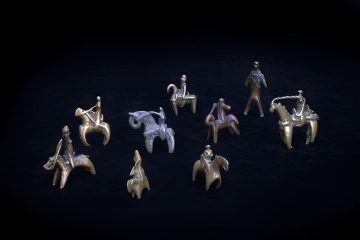
Hadjer-Lamis or Chari-Baguirmi Regions, Chad, or Far North Region, Cameroon
Equestrian and archer amulet figures (putchu guinadj)
19th to early 20th century
Copper alloy
Collection of Arnold and Joanne Syrop
Hero in History: Idris Aloma
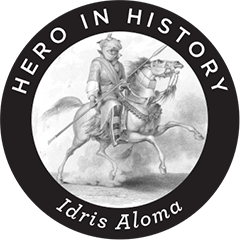
- Aloma became mai (king) of Bornu during a period of famine and internal strife.
- A devout Muslim, Aloma returned to Mecca from the hajj with Turkish muskets and soldiers who helped him build his cavalry. He also built diplomatic alliances with Ottoman and Moroccan rulers.
- Aloma is remembered as a sensible ruler and administrative reformer who—through alliances and adherence to Islamic justice—made Bornu prosperous, prominent, and protected.
A lone woman clad in gold might walk [the empire’s roads] with none to fear but God.
—Ibn Fartuwa, chronicler of Idris Aloma’s reign, describing the security of the Bornu EmpireGraphic novels
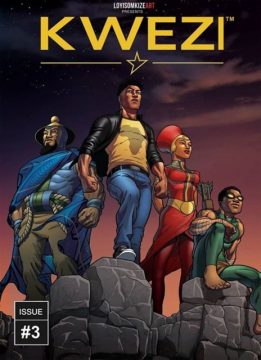
b. 1987, Butterworth, Eastern Cape Province, South Africa
Works in Cape Town, South Africa
Kwezi
2016; published in Cape Town by David Philip Publishers
Warren M. Robbins Library, National Museum of African Art
Kwezi tells the story of a young, city-dwelling South African superhero challenged to use his great powers for the greater good.
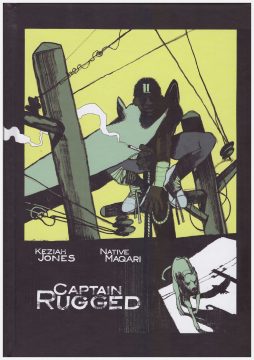
b. 1968, Lagos, Nigeria
Works in Lagos
Captain Rugged
2013; published in Bologna, Italy, by Damiani
Warren M. Robbins Library, National Museum of African Art
Captain Rugged is a Lagos-based superhero fighting greedy local and multinational corporate interests that threaten the city’s disempowered.
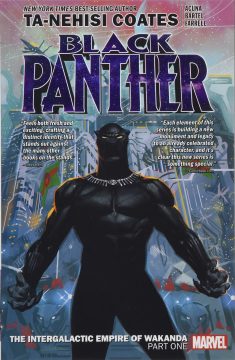
b. 1975, Baltimore
Works in Brooklyn
Black Panther
Illustrations by Brian Stelfreeze
2016–ongoing; published in New York by Marvel Worldwide
Warren M. Robbins Library, National Museum of African Art
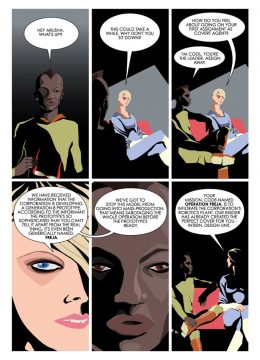
b. 1974, Lusaka, Zambia
Works in Toronto
Ananiya the Revolutionist
2013–ongoing
Exhibition prints
Courtesy of the artist
Ananiya the Revolutionist is a 17-year old black female resistance fighter in the Army for the Restoration of Womanhood; she fights against a corporate government that has introduced sex robots capable of replacing the need for female humans.
Hero in History: Frantz Fanon
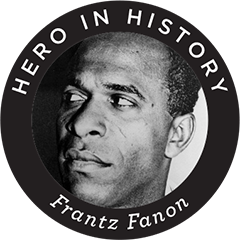
- After serving in the Free French army in World War II, Fanon studied psychiatry, taking a position in French-ruled Algeria in 1953. There, he witnessed firsthand the traumatic effects of colonial violence on the human psyche.
- In books like Black Skin, White Masks (1952) and The Wretched of the Earth (1961), Fanon analyzed the psychological impacts of colonial rule, framing them as a form of violent domination of the psyche—but also as a set of tools that the colonized could take up and reverse in self-defense.
- Fanon also critiqued many postcolonial governments for their perceived dependence on former colonial powers and failures to build a national consciousness in their people.
- Fanon’s writings were inspirations to a global swathe of anticolonial and liberation movements in the second half of the 20th century—setting the struggle for freedom first in the psyche and the imagination.
He who is reluctant to recognize me opposes me.
—Frantz Fanon, Black Skin, White MasksImperialism leaves behind germs of rot which we must clinically detect and remove from our land but from our minds as well.
—Frantz Fanon, The Wretched of the Earth
Home | That Liberty and Equality Might Yet Reign | Ethiopia—Divine Endurance | Independent Africa Faces Forward | Our Ancestors Lived Free | Legends—Looking Back, Facing Forward | We Are…: Women Warriors | South Africa—A Long Walk to Freedom
